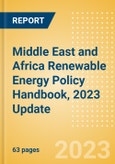1. Executive Summary2. Renewable Energy Policy, Algeria
2.1 Renewable Energy Market, Overview
2.2 Policy Snapshot
2.3 Renewable Energy Targets
2.4 Hydrogen Energy
2.5 Energy Transition Plan
2.6 Auctions
2.7 Feed in Tariffs for Wind and Solar
2.8 Intended Nationally Determined Contribution (INDC) to the Paris Agreement
2.9 Foreign Investment Laws and Regulations
2.10 Algeria Renewable Energy Program (AREP)
3. Renewable Energy Policy, Egypt
3.1 Renewable Energy Market, Overview
3.2 Policy Snapshot
3.3 Renewable Energy Targets
3.4 Electricity Law No. 87 of 2015
3.5 Renewable Energy Law (Decree No. 203/2014)
3.6 Integrated Sustainable Energy Strategy (ISES) 2035
3.7 Build, Own, Operate, and Transfer (BOOT) Scheme
3.8 Reverse Auctions
3.9 Incentives on Renewable Energy Equipment
3.10 Net Metering Scheme
3.11 Waste to Energy Tariff
3.12 Sovereign Guarantee
3.13 Wheeling Schemes
3.14 Tax incentives for green energy investment
4. Renewable Energy Policy, Iran
4.1 Renewable Energy Market, Overview
4.2 Policy Snapshot
4.3 Renewable Energy Targets
4.4 Hydrogen Energy
4.5 Feed-in Tariffs
4.6 Renewable Energy Development Fund
4.7 Renewable Portfolio Standards
4.8 Support for IPPs to Export Electricity to Neighbouring Countries
4.9 Call for Auction
4.10 Sixth Development Plan
5. Renewable Energy Policy, Kuwait
5.1 Renewable Energy Market, Overview
5.2 Policy Snapshot
5.3 Renewable Energy Targets
5.4 Innovative Renewable Energy Research Program
5.5 Renewable Energy Building and Site Integration
5.6 Environment Protection Law
6. Renewable Energy Policy, Nigeria
6.1 Renewable Energy Market, Overview
6.2 Policy Snapshot
6.3 Renewable Energy Targets
6.4 Renewable Energy Master Plan (REMP)
6.5 National Renewable Energy and Energy Efficiency Policy (NREEP)
6.6 Off-grid Electrification Strategy
6.7 Multi-Year Tariff Order (MYTO)
6.8 Feed-in Tariffs (FiTs)
6.9 Net Metering
6.10 Competitive Procurement
6.11 Nigerian Economic Sustainability Plan
6.12 Green Bonds
6.13 Solar Hybrid Mini Grid Fund
7. Renewable Energy Policy, Saudi Arabia
7.1 Renewable Energy Market, Overview
7.2 Policy Snapshot
7.3 Renewable Energy Targets
7.4 Hydrogen Energy
7.5 Saudi Vision 2030 and National Renewable Energy Program (NREP)
7.6 Saudi Green Initiative
7.7 Net Metering
7.8 Renewable Energy Auctions
7.9 National Industrial Cluster Development Program
7.10 Energy Research Innovation Program
7.11 Nationally Determined Contributions (NDC)
8. Renewable Energy Policy, South Africa
8.1 Renewable Energy Market, Overview
8.2 Policy Snapshot
8.3 Renewable Energy Targets
8.4 Hydrogen Energy
8.5 Renewable Energy Independent Power Producer Procurement Program (REIPPPP)
8.6 Integrated Energy Plan (IEP)
8.7 Integrated Resource Plan (IRP)
8.8 Net Metering
8.9 Rooftop PV Feed-in Tariff
8.10 Local Content Requirement (LCR)
8.11 Tax incentives
8.12 Green Fund
9. Renewable Energy Policy, UAE
9.1 Renewable Energy Market, Overview
9.2 Policy Snapshot
9.3 Renewable Energy Targets
9.4 Dubai Integrated Energy Strategy 2030
9.5 Smart Dubai Initiatives
9.6 Dubai Clean Energy Strategy 2050
9.7 UAE Energy Strategy 2050
9.8 Net Metering
9.9 Green Building Code
9.10 Renewable Energy Auctions
9.11 Overseas Renewable Energy Development Assistance Programme
9.12 National Climate Change Plan 2050
9.13 Clean Energy Certificates
10. Appendix
10.1 Abbreviations
10.2 Market Definitions
10.3 Methodology
- Coverage
- Secondary Research
- Primary Research
- Modelling and Forecasting
- Contact the Publisher
List of Tables
Table 1: Renewable Energy Policy, Middle East, and Africa, 2023
Table 2: Policy Snapshot, Algeria, 2022
Table 3: Solar PV Tender Details, Algeria, 2018
Table 4: Solar PV Feed-in Tariffs, Algeria
Table 5: Wind Power Feed-in Tariffs, Algeria
Table 6: Policy Snapshot, Egypt, 2022
Table 7: Policy Snapshot, Iran, 2022
Table 8: Feed-in Tariffs, For Power Plants with Capacity less than 10MW, Iran, 2021
Table 9: Feed-in Tariffs, Small Renewable Generators, Iran, 2021
Table 10: Policy Snapshot, Kuwait, 2022
Table 11: Policy Snapshot, Nigeria, 2022
Table 12: Multi-Year Tariff Order, Nigeria, 2017-2022
Table 13: Feed-in Tariffs, Nigeria
Table 14: Policy Snapshot, Saudi Arabia, 2022
Table 15: Policy Snapshot, South Africa, 2022
Table 16: Capacity Awarded, South Africa, 2011-2022
Table 17: Price Trend of Solar PV ($/kWh), REIPPPP, South Africa, 2011-2022
Table 18: Price Trend of Onshore Wind ($/kWh), REIPPPP, South Africa, 2011-2022
Table 19: Policy Snapshot, UAE, 2022
Table 20: Abbreviations
List of Figures
Figure 1: Renewable Auctions, Budget ($M) vs Allocation ($M), Flanders, Belgium, 2021-2022
Figure 2: Solar PV Auctions, Flanders, Belgium, 2021-2022
Figure 3: Solar PV Prices, Flanders, Belgium, 2021-2022
Figure 4: Renewable Auctions, Auctioned Capacity (MW) Vs. Awarded Capacity (MW), France, 2017-2022
Figure 5: Renewable Auctions, Awarded Capacity (MW) by Technology, France, 2017-2022
Figure 6: Solar PV Auctions, Germany, 2018-2022
Figure 7: Onshore Wind Auctions, Germany, 2018-2022
Figure 8: Biomass Auctions, Germany, 2018-2022
Figure 9: Renewable Auctions, Category A, Auctioned Capacity Vs. Awarded Capacity, Italy, 2019-2022
Figure 10: Renewable Auctions, Category A, Awarded Capacity by Technology, Italy, 2019-2023
Figure 11: Renewable Auctions, Auctioned Capacity Vs. Awarded Capacity, Spain, 2016-2022
Figure 12: Renewable Auctions, Solar PV and Onshore Wind, Spain, 2021-2022








